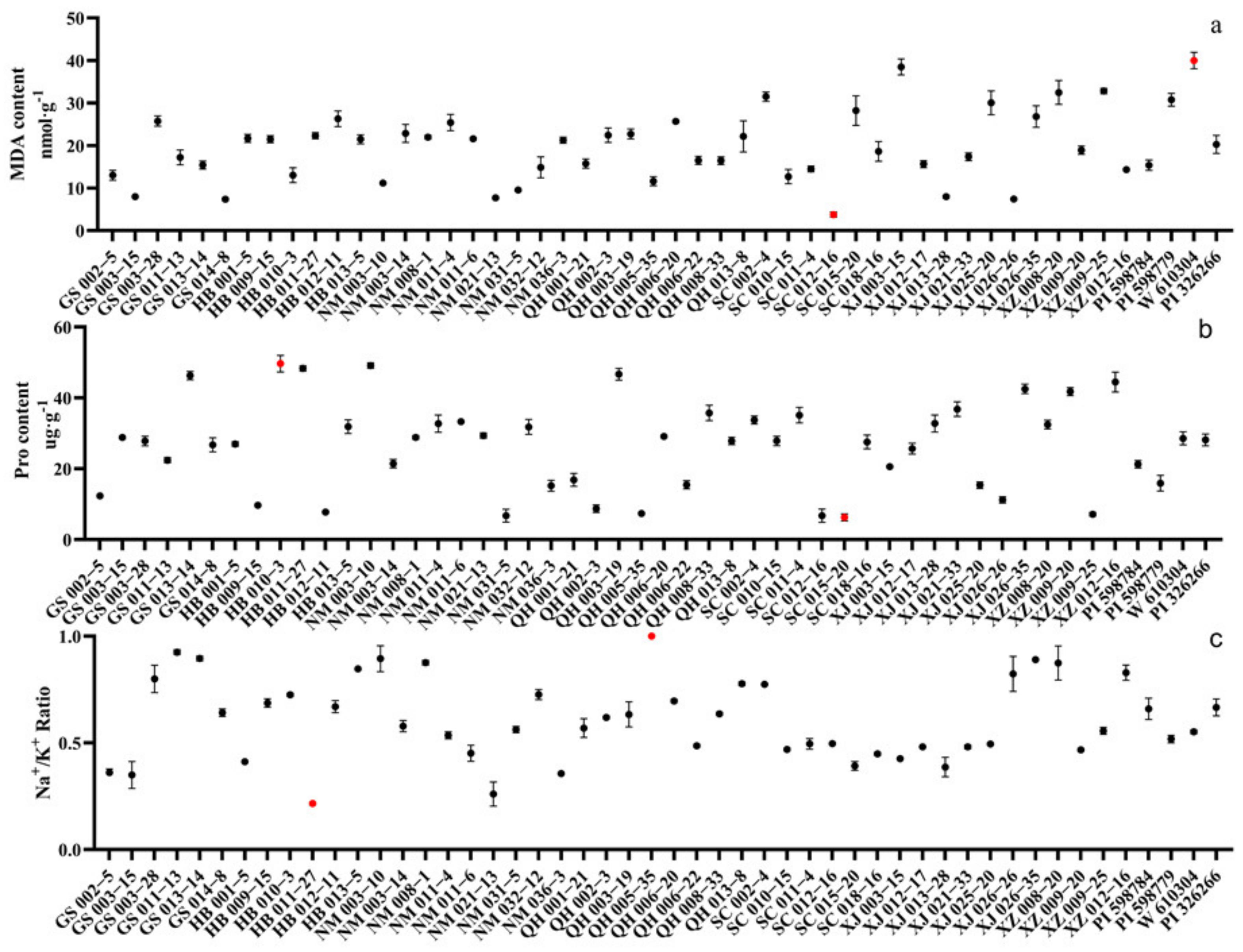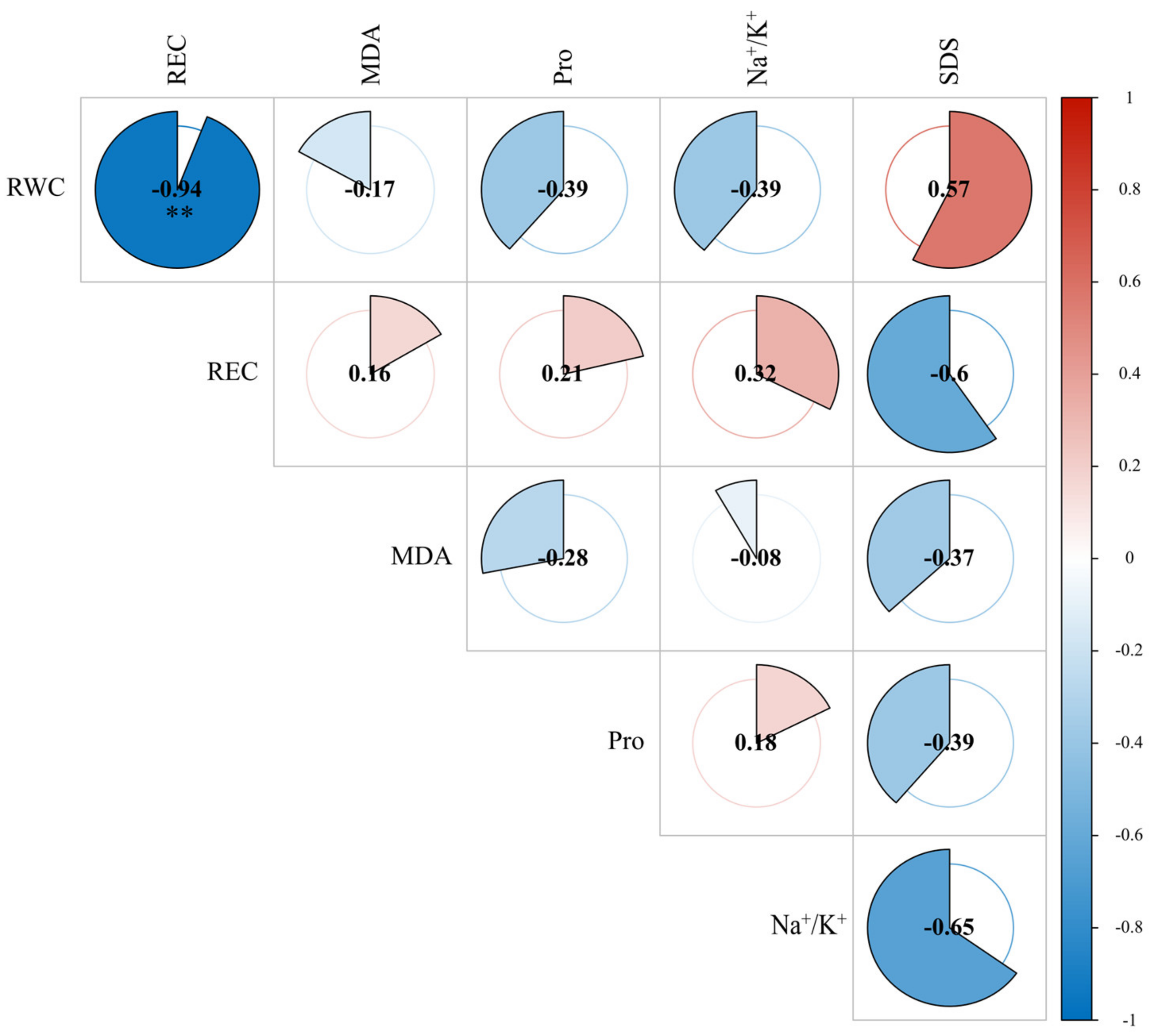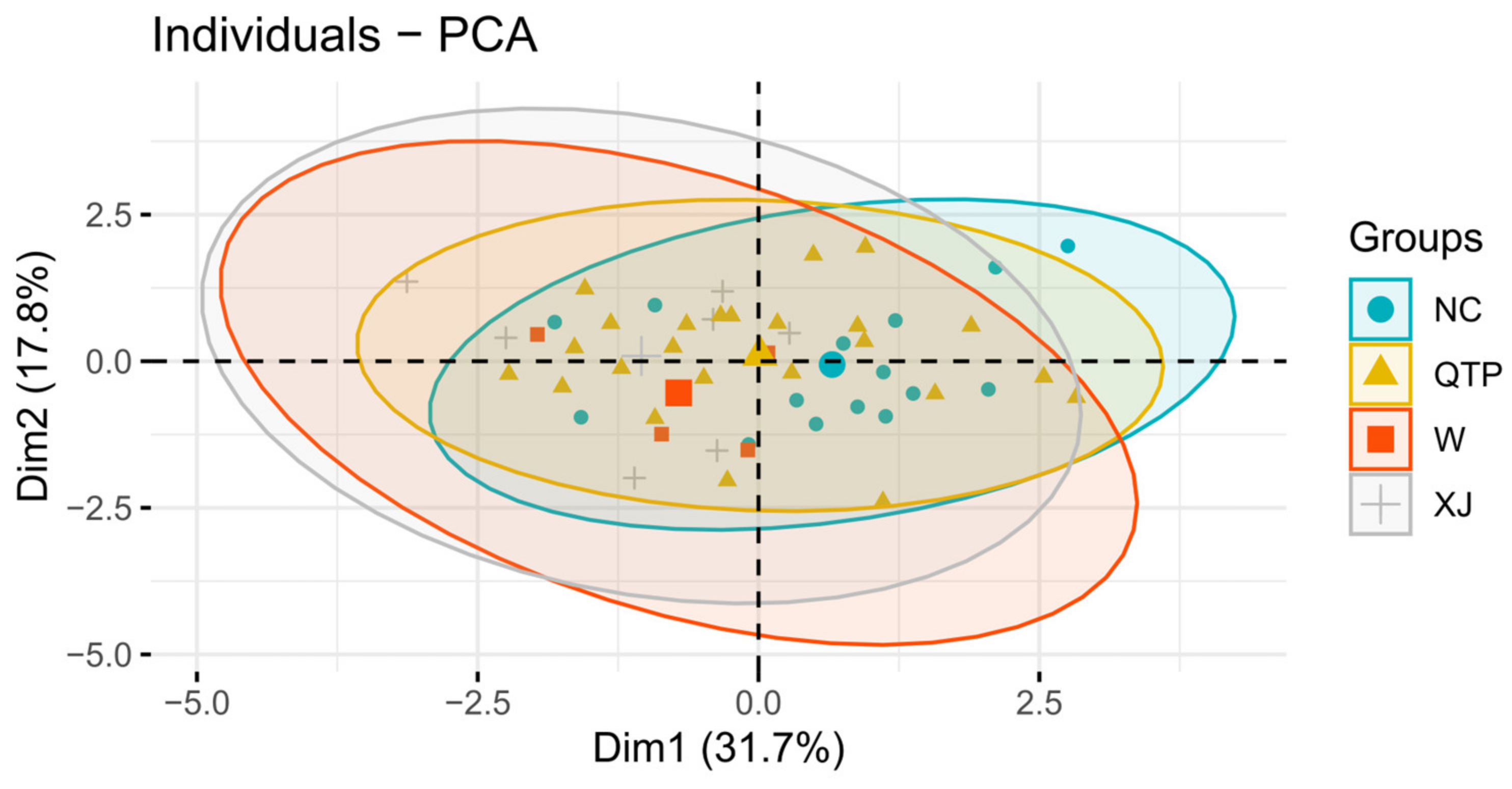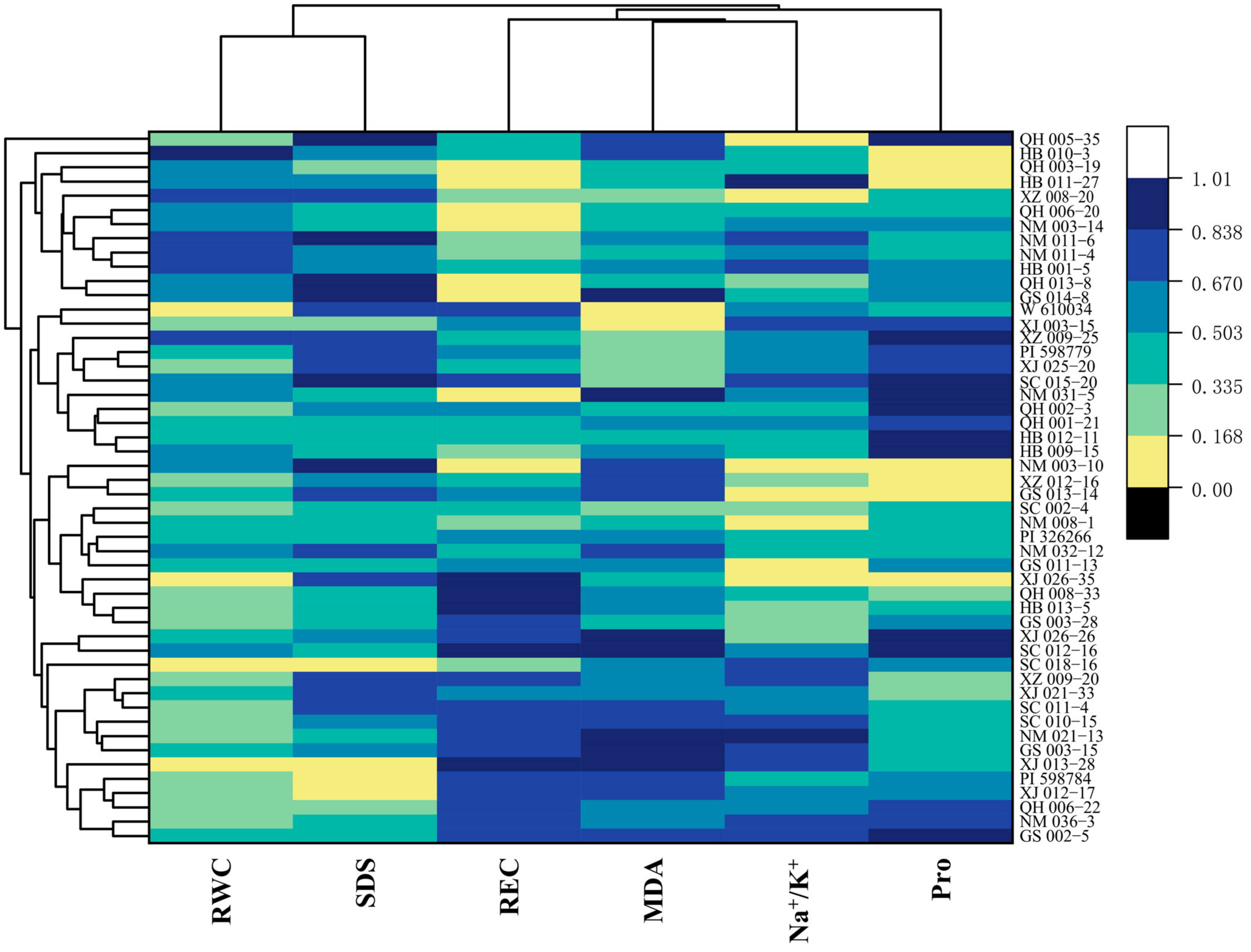Evaluation and Screening of Wild Elymus sibiricus L. Germplasm Resources under Salt Stress
Abstract
:1. Introduction
2. Materials and Methods
2.1. Materials, Resources, and Experimental Design
2.2. Measurement Indices
2.2.1. Relative Water Content (RWC)
2.2.2. Relative Electrical Conductivity (REC)
2.2.3. Malondialdehyde Content (MDA) and Proline Content (Pro)
2.2.4. Na+/K+ Ratio
2.2.5. Salt Damage Score (SDS)
2.3. Data Statistics and Analysis
- where μ is the expected value; W is the weight value corresponding to variable X (the proportion of the contribution rate of the corresponding variable and the cumulative contribution rate); and D is the comprehensive evaluation value of salinity tolerance obtained from the evaluation of each index under salt stress, with higher values indicating stronger salinity tolerance.
3. Results
3.1. Physiological Response of E. sibiricus under Salt Stress
3.2. Correlation Analysis and Principal Component Analysis
3.3. Cluster Analysis
3.4. Comprehensive Evaluation of Salt Tolerance
4. Discussion
5. Conclusions
Supplementary Materials
Author Contributions
Funding
Data Availability Statement
Acknowledgments
Conflicts of Interest
References
- Giordano, M.; Petropoulos, S.A.; Rouphael, Y. Response and Defence Mechanisms of Vegetable Crops against Drought, Heat and Salinity Stress. Agriculture 2021, 11, 463. [Google Scholar] [CrossRef]
- Huang, J.; Kong, Y.L.; Xu, Q.S.; Zhu, C.Q.; Zhu, L.F.; Cao, X.C.; Hong, X.Z.; Zhang, J.H. Progresses for Characteristics and Amelioration Measures of Saline Soil. Soils 2022, 54, 18–23. [Google Scholar]
- Muchate, N.S.; Nikalje, G.C.; Rajurkar, N.S.; Suprasanna, P.; Nikam, T.D. Plant Salt Stress: Adaptive Responses, Tolerance Mechanism and Bioengineering for Salt Tolerance. Bot. Rev. 2016, 82, 371–406. [Google Scholar] [CrossRef]
- Ben, H.A.; Ghneim, H.T.; Ben, R.W.; Dabbous, A.; Ben, S.R.; Brini, F.; Abdelly, C.; Ben, H.K. Early effects of salt stress on the physiological and oxidative status of the halophyte Lobularia maritima. Funct. Plant Biol. 2020, 47, 912. [Google Scholar] [CrossRef]
- Sadaqat, S.S.; Li, Z.; Yan, H.; Shi, L.; Zhou, B. Comparative Study of the Effects of Salinity on Growth, Gas Exchange, N Accumulation and Stable Isotope Signatures of Forage Oat (Avena sativa L.) Genotypes. Plants 2020, 9, 1025. [Google Scholar] [CrossRef]
- Wang, W.; Zhao, Y.; Wang, W.; Xu, K.; Niu, L.; Yu, L.; Zou, J.; Wang, Z.; Zhang, Y.; Wang, F.; et al. Evaluation of Salt Tolerance Mechanism and Study on Salt Tolerance Relationship of Different Salt-Tolerant Wheat Varieties. Comput. Intell. Neurosci. 2022, 2022, 2395568. [Google Scholar] [CrossRef]
- Zuo, Z.F.; Kang, H.; Park, M.Y.; Jeong, H.; Sun, H.; Song, P.; Lee, H.Y. Zoysia japonica MYC type transcription factor ZjICE1 regulates cold tolerance in transgenic Arabidopsis. Plant Sci. 2019, 289, 110254. [Google Scholar] [CrossRef]
- Zou, J.; Liu, C.; Liu, A.; Zou, D.; Chen, X. Overexpression of OsHsp17.0 and OsHsp23.7 enhances drought and salt tolerance in rice. J. Plant Physiol. 2012, 169, 628–635. [Google Scholar] [CrossRef]
- Wang, Y. Evaluation of Salt Tolerance of Different Types of Tobacco and Physiological Mechanism of Salinity Stress Tolerance at Seeding Stage. Master’s Dissertation, Henan Agricultural University, Zhengzhou, China, 2021. [Google Scholar]
- Hu, D.D.; Li, R.F.; Dong, S.T.; Zhang, J.W.; Zhao, B.; Ren, B.Z.; Ren, H.; Yao, H.Y.; Wang, Z.Q.; Liu, Z. Maize (Zea mays L.) responses to salt stress in terms of root anatomy, respiration and antioxidative enzyme activity. BMC Plant Biol. 2022, 22, 602. [Google Scholar] [CrossRef]
- Bargaz, A.; Zaman, A.M.; Farissi, M.; Lazali, M.; Drevon, J.J.; Maougal, R.; Georg, C. Physiological Physiological and molecular aspects of tolerance to environmental constraints in grain and forage legumes. Int. J. Mol. Sci. 2015, 16, 18976–19008. [Google Scholar] [CrossRef]
- Wang, X.D.; Wang, C.; Ma, Z.H.; Hou, R.F.; Gao, Q.; Chen, Q. Effect of short-term salt stress on the absorption of K+ and accumulation of Na+, K+ in seedlings of different wheat varieties. Acta Ecol. Sin. 2011, 31, 2822–2830. [Google Scholar]
- Wei, B.X. Distribution and Cause Analysis of Saline—Alkaline Soil in China. Technol. Soil Water Conserv. 2012, 6, 27–28. [Google Scholar]
- Yang, J.S.; Yao, R.J.; Wang, X.P.; Xie, W.P.; Zhang, X.; Zhu, W.; Zhang, L.; Sun, R.J. Research on Salt-affected Soils in China: History, Status Quo and Prospect. Acta Pedol. Sin. 2022, 59, 10–27. [Google Scholar]
- Huang, F.; Li, Z.Y.; Li, H.Y.; Shi, W.G.; Bai, W.J.; Liu, L.; Li, J.; Xie, Y.F. Analysis of Morphological Diversity of Elymus sibiricus L. Germplasm Resources. Chin. J. Grassl. 2015, 37, 111–115. [Google Scholar]
- Yan, X.B. Study of Genetic Diversity of Elymus Species. Ph.D. Dissertation, China Agricultural University, Beijing, China, 2005. [Google Scholar]
- Li, M.F.; Li, X.R.; Li, Y.Z.; Chen, L.L.; Wang, Y.; Li, C.Y.; Chang, D.; Lei, X.; Yan, L.J.; You, M.H.; et al. Identification of Wild Elymus sibiricus Germplasm Resources and Analysis of Variation of Dorsal Hairs in Basal Leaf Sheath. Acta Prataculturae Sin. 2023, 31, 1026–1035. [Google Scholar]
- Peng, J.; Sun, X.X.; Shi, H.T.; Chen, Y.J.; Cai, X.R.; Wang, X.; Bai, X.; Li, S.L. Nutritional Value and Molecular Structure Characteristics in Different Fractions of Elymus sibiricus from Qinghai-Tibet Plateau. Chin. J. Anim. Nutr. 2022, 34, 5270–5282. [Google Scholar]
- Zeng, H.G.; Yue, J.M.; Zhang, S.H.; Yi, K.; Wei, K.; Yang, S.F.; Liu, G.X.; Li, M.L.; Yang, C.H. Comprehensive Evaluation of Agronomic Traits of 76 Germplasm Resources of Elymus sibiricus. Acta Agrestia Sin. 2022, 30, 3046–3055. [Google Scholar]
- Zhang, Z.; Zheng, Y.; Zhang, J.; Wang, N.; Wang, Y.; Liu, W.; Bai, S.; Xie, W. High-Altitude Genetic Selection and Genome-Wide Association Analysis of Yield-Related Traits in Elymus sibiricus L. Using SLAF Sequencing. Front. Plant Sci. 2022, 13, 874409. [Google Scholar] [CrossRef]
- Guo, Y.; Liu, Y.; Zhang, Y.; Liu, J.; Gul, Z.; Guo, X.R.; Abozeid, A.; Tang, Z.H. Effects of Exogenous Calcium on Adaptive Growth, Photosynthesis, Ion Homeostasis and Phenolics of Gleditsia sinensis Lam. Plants under Salt Stress. Agriculture 2021, 11, 978. [Google Scholar] [CrossRef]
- You, J.; Zhang, J.; Wang, W.R.; Lu, J.; Jia, P.X.; Miao, J.S.; Yang, Y.L. Changes of Physiological Properties in Limonium aureum(Linn.) Hill Seedlings under Salt Stress. Bull. Bot. Res. 2013, 33, 45–50. [Google Scholar]
- Wang, N.; Yang, J.; Huang, Q.; Su, G.L.; Zhou, H.; Xu, Q.H.; Dong, H.L.; Yan, G.T. Physiological Salinity Tolerance Mechanism for Transport of K+ and Na+ Ions in Cotton (Gossypium hirsutum L.) Seedlings under Salt Stress. Cotton Sci. 2015, 27, 208–215. [Google Scholar]
- Han, L.Z.; Gen, L.Y.; Ma, X.D.; Cui, D.; Wang, C.L.; Zhang, Q.X. Technical Code of Practice for Identification of Salt Tolerance in Rice; NY/T 3692-2020; Ministry of Agiculture and Rural Affairs of the People’s Republic of China: Beijing, China, 2020. Available online: http://www.jgj.moa.gov.cn/nybz/202009/t20200924_6353165.htm (accessed on 24 September 2020).
- Liang, S.; Xiong, W.; Yin, C.; Xie, X.; Jin, Y.; Zhang, S.; Yang, B.; Ye, G.; Chen, S.; Luan, W. Overexpression of OsARD1 Improves Submergence, Drought, and Salt Tolerances of Seedling Through the Enhancement of Ethylene Synthesis in Rice. Front. Plant Sci. 2019, 10, 1088. [Google Scholar] [CrossRef] [PubMed]
- Zhu, B.; Zheng, S.; Fan, W.; Zhang, M.; Xia, Z.; Chen, X.; Zhao, A. Ectopic overexpression of mulberry MnT5H2 enhances melatonin production and salt tolerance in tobacco. Front. Plant Sci. 2022, 13, 1061141. [Google Scholar] [CrossRef] [PubMed]
- Zhao, N.; Sheng, M.; Zhao, J.; Ma, X.; Wei, Q.; Song, Q.; Zhang, K.; Xu, W.; Sun, C.; Liu, F.; et al. Over-Expression of HDA710 Delays Leaf Senescence in Rice (Oryza sativa L.). Front. Bioeng. Biotechnol. 2020, 8, 471. [Google Scholar] [CrossRef]
- Zhang, Z.Y.; Li, X.; Wang, Y.; Chang, W.; Gao, X.Q.; Fu, B.Z. Salt Tolerance Evaluation and Salt Tolerance Index Screening of 59 Alfalfa Germplasm Materials at Seedling Stage. Acta Agrestia Sin. 2020, 28, 112–121. [Google Scholar]
- Zhang, Z.R.; Zhang, X.W.; Jiang, W.; Wang, B.B.; Sun, H.D.; Wang, Y.S.; Luo, J.X. Responses of Growth and Physiological Characteristics of Three Ground Cover Plants to Salinity Stress. Tianjin Agric. Sci. 2017, 23, 20–24. [Google Scholar]
- Han, Z.P.; Zhang, H.X.; Zhou, F. Effect of Salinity on Plant and Adaptation of Plant to Salinity. J. Shanxi Datong Univ. (Nat. Sci.) 2015, 31, 59–62. [Google Scholar]
- Wang, Y.F. Responses of Maize Seedling under NaCl Stress and the Regulatory Mechanism of Salt Tolerance. Ph.D. Dissertation, Shenyang Agricultural University, Shenyang, China, 2008. [Google Scholar]
- Mi, Y.W.; Wang, G.X.; Gong, C.W.; Cai, Z.P.; Wu, W.G. Effects of Salt stress on growth and physiology of Isatis indigotica seedlings. Acta Pratacult. Sin. 2018, 27, 43–51. [Google Scholar]
- Li, Y.; Liu, G.B.; Gao, H.W.; Sun, G.Z.; Zhao, H.M.; Xie, N. A comprehensive evaluation of salt-tolerance and the physiological response of Medicago sativa at the seedling stage. Acta Pratacultu. Sin. 2010, 19, 79–86. [Google Scholar]
- Zhang, R.Q.; Chen, H.; Wang, R.Q. Screening on Salt-tolerant Germplasm Resource of Triticale. Seed 2016, 35, 61–64. [Google Scholar]
- Liu, W.; Li, J.; Yang, F.; Huang, J.; Wei, Y.; Jin, Q. Effects of Salt Stress on Seed Germination of 40 Quinoa Germplasm and Evaluation of Salt Tolerance. Mol. Plant Breed. 2021, 19, 938–995. [Google Scholar]
- Yang, Y.J.; Zhang, H.; Zhou, H.K.; Wang, W.Y.; Yin, H.X.; Yao, B.Q.; Zhao, X.Q. Effect of Salt Stress on Physiological Characteristics of Alpine Grassland Pasture Elymus sibiricus. Acta Agric. Boreali-Occident. Sin. 2015, 24, 156–162. [Google Scholar]
- Yang, Y.J.; Zhou, H.K.; Wang, W.Y.; Yin, H.X.; Yao, B.Q.; Yu, X.C.; Zhao, X.Q.; Wang, F.G. Effect of salt stess on the physiological characteristics of Elymus nutans. J. Lanzhou Univ. 2014, 50, 101–106. [Google Scholar]
- Zhao, Z.J.; Zhang, H.L.; Wang, M.J.; Zhang, X.M.; Li, L.X. Salt stress-related regulation mechanism of intracellular pH and ion homeostasis in plants. Plant Physiol. J. 2020, 56, 337–344. [Google Scholar]
- Porcel, R.; Aroca, R.; Azcon, R.; Ruiz-Lozano, J.M. Regulation of cation transporter genes by the arbuscular mycorrhizal symbiosis in rice plants subjected to salinity suggests improved salt tolerance due to reduced Na+ root-to-shoot distribution. Mycorrhiza 2016, 26, 673–684. [Google Scholar] [CrossRef]
- Wang, M.M.; Zhou, X.R.; Liang, G.L.; Zhao, G.Q.; Jiao, R.A.; Chai, J.K.; Gao, X.M.; Li, J.N. A multi-trait evaluation of salt tolerance of 5 oat germplasm lines at lines at seedling stage. Acta Pratacult. Sin. 2020, 29, 143–154. [Google Scholar]
- Li, X.; Sha, B.P.; Gao, X.Q.; Wang, Y.; Fu, B.Z. Identification and Comprehensive Evaluation of Salt Tolerance of Alfalfa Germplasm Materials at Germination Stage. Acta Agrestia Sin. 2020, 28, 437–445. [Google Scholar]
- Gao, Z.W. Research on the Salt-Alkali Resistance Mechanism of Alfalfa an Oat. Ph.D. Dissertation, Northeast Normal University, Changchun, China, 2011. [Google Scholar]
- Peng, Z.; Li, L.; Liu, Y.P.; Liu, H.M.; Jing, R.L. Evaluation of Salinity Tolerance in Wheat (Triticum aestium) Genotypes at Germination and Seedling Stages. J. Plant Genet. Resour. 2017, 18, 638–645. [Google Scholar]
- Sheng, W.; Wu, X.C.; Liang, H.; Li, C.Y.; Ma, Y.Y.; Zhang, J.X.; Ding, X.P.; Li, X.Y.; Liu, G.D. Evaluation of salt tolerance in 41 pigeon pea varieties during germination. Pratacult. Sci. 2022, 39, 1607–1617. [Google Scholar]







| Indicators | Mean | Min | Max | Standard Deviation | Coefficient of Variation (%) | F | p |
|---|---|---|---|---|---|---|---|
| RWC (%) | 82.89 | 59.43 | 97.65 | 7.986 | 9.633 | 3.55 | <0.01 |
| REC (%) | 56.93 | 18.46 | 96.97 | 21.62 | 37.97 | 676.60 | <0.01 |
| MDA (nmol·g−1) | 19.61 | 3.28 | 42.16 | 8.298 | 42.31 | 87.25 | <0.01 |
| Pro (μg·g−1) | 26.35 | 5.38 | 52.16 | 12.51 | 47.50 | 220.01 | <0.01 |
| Na+/K+ | 0.6075 | 0.2 | 1 | 0.1906 | 31.37 | 111.62 | <0.01 |
| SDS | 2.864 | 1.7 | 4.2 | 0.582 | 20.32 | 79.38 | <0.01 |
| Items | Measures of Sampling Adequacy (MSA) |
|---|---|
| KMO | 0.52 |
| Bartlett (p value) | 0.0099 |
| RWC | 0.50 |
| REC | 0.53 |
| MDA | 0.31 |
| PRO | 0.69 |
| Na+/K+ | 0.52 |
| SDS | 0.59 |
| Ingredients | Eigenvalue | Contribution Rate (%) | Total Contribution Rate (%) |
|---|---|---|---|
| 1 | 1.965 | 32.745 | 32.745 |
| 2 | 1.068 | 17.8 | 50.545 |
| 3 | 1.004 | 16.736 | 67.28 |
| 4 | 0.869 | 14.487 | 81.767 |
| 5 | 0.762 | 12.698 | 94.465 |
| 6 | 0.332 | 5.535 | 100 |
| Indicators | Ingredients | ||
|---|---|---|---|
| 1 | 2 | 3 | |
| W | 0.487 | 0.264 | 0.249 |
| RWC | −0.408 | 0.099 | 0.43 |
| REC | 0.398 | 0.095 | −0.325 |
| MDA | 0.079 | 0.794 | 0.228 |
| PRO | 0.177 | −0.512 | 0.354 |
| Na+/K+ | 0.227 | −0.062 | 0.694 |
| SDS | −0.309 | −0.145 | −0.216 |
| Code | D Values | Order | Code | D Values | Order |
|---|---|---|---|---|---|
| XJ 013-28 | 0.7345 | 1 | QH 003-19 | 0.4016 | 26 |
| NM 021-13 | 0.6663 | 2 | GS 003-28 | 0.3889 | 27 |
| SC 012-16 | 0.636 | 3 | GS 011-13 | 0.3841 | 28 |
| XJ 012-17 | 0.6132 | 4 | SC 015-20 | 0.3834 | 29 |
| GS 002-5 | 0.5946 | 5 | HB 009-15 | 0.3824 | 30 |
| QH 006-22 | 0.5892 | 6 | GS 014-8 | 0.3763 | 31 |
| PI 598784 | 0.5824 | 7 | HB 012-11 | 0.3758 | 32 |
| GS 003-15 | 0.5699 | 8 | XZ 012-16 | 0.3713 | 33 |
| SC 010-15 | 0.5497 | 9 | NM 003-14 | 0.3707 | 34 |
| SC 018-16 | 0.5396 | 10 | NM 032-12 | 0.3698 | 35 |
| NM 036-3 | 0.5312 | 11 | XJ 025-20 | 0.3542 | 36 |
| QH 008-33 | 0.522 | 12 | NM 008 -1 | 0.3473 | 37 |
| NM 031-5 | 0.4931 | 13 | NM 011-4 | 0.3451 | 38 |
| QH 001-21 | 0.4844 | 14 | GS 013-14 | 0.335 | 39 |
| XJ 026-26 | 0.4778 | 15 | PI 598779 | 0.3304 | 40 |
| SC 011-4 | 0.4736 | 16 | XJ 026-35 | 0.3277 | 41 |
| XZ 009-25 | 0.4554 | 17 | NM 011-6 | 0.323 | 42 |
| HB 011-27 | 0.442 | 18 | SC 002-4 | 0.3137 | 43 |
| HB 013-5 | 0.4363 | 19 | QH 006-20 | 0.3074 | 44 |
| XJ 021-33 | 0.4283 | 20 | W 610304 | 0.3024 | 45 |
| QH 002-3 | 0.427 | 21 | QH 005-35 | 0.2995 | 46 |
| HB 001-5 | 0.4244 | 22 | NM 003-10 | 0.29 | 47 |
| PI 326266 | 0.4198 | 23 | XZ 009-20 | 0.2822 | 48 |
| XJ 003-15 | 0.4044 | 24 | QH 013-8 | 0.2304 | 49 |
| HB 010-3 | 0.4033 | 25 | XZ 008-20 | 0.172 | 50 |
| Code | D Values | Order | Code | D Values | Order |
|---|---|---|---|---|---|
| XJ 013-28 | 0.8547 | 1 | PI 326266 | 0.5041 | 26 |
| NM 021-13 | 0.7354 | 2 | GS 013-14 | 0.4848 | 27 |
| XJ 012-17 | 0.7073 | 3 | XJ 026-26 | 0.4836 | 28 |
| QH 008-33 | 0.6883 | 4 | QH 002-3 | 0.4716 | 29 |
| SC 010-15 | 0.6706 | 5 | SC 002-4 | 0.4686 | 30 |
| PI 598784 | 0.6494 | 6 | GS 011-13 | 0.4571 | 31 |
| QH 006-22 | 0.6458 | 7 | HB 001-5 | 0.4546 | 32 |
| GS 003-15 | 0.6299 | 8 | XJ 025-20 | 0.4447 | 33 |
| XZ 009-25 | 0.6268 | 9 | NM 032-12 | 0.4447 | 34 |
| SC 018-16 | 0.622 | 10 | NM 008-1 | 0.4309 | 35 |
| GS 002-5 | 0.6139 | 11 | SC 015-20 | 0.4305 | 36 |
| HB 013-5 | 0.6024 | 12 | NM 011-4 | 0.4211 | 37 |
| SC 011-4 | 0.6007 | 13 | NM 031-5 | 0.4127 | 38 |
| SC 012-16 | 0.5997 | 14 | NM 003-10 | 0.4114 | 39 |
| NM 036-3 | 0.5871 | 15 | PI 598779 | 0.4045 | 40 |
| XJ 026-35 | 0.5675 | 16 | GS 014-8 | 0.3904 | 41 |
| HB 011-27 | 0.5574 | 17 | NM 011-6 | 0.39 | 42 |
| XJ 021-33 | 0.5547 | 18 | HB 012-11 | 0.3886 | 43 |
| GS 003-28 | 0.538 | 19 | NM 003-14 | 0.3835 | 44 |
| XZ 012-16 | 0.5163 | 20 | QH 006-20 | 0.3686 | 45 |
| XJ 003-15 | 0.5153 | 21 | HB 009-15 | 0.3672 | 46 |
| W 610304 | 0.5151 | 22 | QH 005-35 | 0.3182 | 47 |
| QH 003-19 | 0.5142 | 23 | QH 013-8 | 0.2868 | 48 |
| QH 001-21 | 0.5096 | 24 | XZ 008-20 | 0.2827 | 49 |
| HB 010-3 | 0.5077 | 25 | XZ 009-20 | 0.2797 | 50 |
Disclaimer/Publisher’s Note: The statements, opinions and data contained in all publications are solely those of the individual author(s) and contributor(s) and not of MDPI and/or the editor(s). MDPI and/or the editor(s) disclaim responsibility for any injury to people or property resulting from any ideas, methods, instructions or products referred to in the content. |
© 2023 by the authors. Licensee MDPI, Basel, Switzerland. This article is an open access article distributed under the terms and conditions of the Creative Commons Attribution (CC BY) license (https://creativecommons.org/licenses/by/4.0/).
Share and Cite
Chen, S.; Feng, J.; Xiong, Y.; Xiong, Y.; Liu, Y.; Zhao, J.; Dong, Z.; Ma, X.; Yan, L. Evaluation and Screening of Wild Elymus sibiricus L. Germplasm Resources under Salt Stress. Agronomy 2023, 13, 2675. https://doi.org/10.3390/agronomy13112675
Chen S, Feng J, Xiong Y, Xiong Y, Liu Y, Zhao J, Dong Z, Ma X, Yan L. Evaluation and Screening of Wild Elymus sibiricus L. Germplasm Resources under Salt Stress. Agronomy. 2023; 13(11):2675. https://doi.org/10.3390/agronomy13112675
Chicago/Turabian StyleChen, Shuming, Junjie Feng, Yi Xiong, Yanli Xiong, Yingjie Liu, Junming Zhao, Zhixiao Dong, Xiao Ma, and Lijun Yan. 2023. "Evaluation and Screening of Wild Elymus sibiricus L. Germplasm Resources under Salt Stress" Agronomy 13, no. 11: 2675. https://doi.org/10.3390/agronomy13112675
APA StyleChen, S., Feng, J., Xiong, Y., Xiong, Y., Liu, Y., Zhao, J., Dong, Z., Ma, X., & Yan, L. (2023). Evaluation and Screening of Wild Elymus sibiricus L. Germplasm Resources under Salt Stress. Agronomy, 13(11), 2675. https://doi.org/10.3390/agronomy13112675






